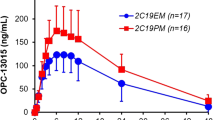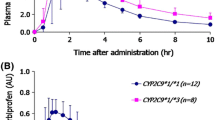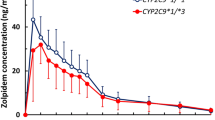Abstract
Objective
To investigate the interaction between allicin and omeprazole and to observe the effects of allicin on CYP2C19 and CYP3A4 activity in healthy Chinese male volunteers with different CYP2C19 genotypes.
Methods
Eighteen subjects (six CYP2C19*1/CYP2C19*1, four CYP2C19*1/CYP2C19*2, two CYP2C19*1/ CYP2C19*3, and six CYP2C19*2/ CYP2C19*2) were enrolled in a two-phase randomized crossover trial. In each phase, all subjects received placebo or a 180 mg allicin capsule once daily for 14 consecutive days. The pharmacokinetics of omeprazole (20 mg orally on day 15) was determined for up to 12 h following administration by high-performance liquid chromatography.
Results
In carriers of the CYP2C19*1/CYP2C19*1 and CYP2C19*1/CYP2C19*2 or *3 genotype, allicin treatment increased the peak plasma concentration (Cmax) of omeprazole by 49.7 ± 7.2 (p < 0.001) and 54.2 ± 9.2% (p < 0.001), and increased the area under the plasma time–concentration curve (\({\text{AUC}}_{\left( {0 - \infty } \right)} \) ) of omeprazole by 48.1 ± 9.0 (p = 0.001) and 73.6 ± 26.7% (p < 0.001), respectively. The ratio of \({\text{AUC}}_{\left( {0 - \infty } \right)} \) of 5-hydroxyomeprazole to omeprazole (a marker for CYP2C19 activity) decreased significantly (p < 0.001 and p = 0.001, respectively). However, no pharmacokinetic parameters were significantly changed by allicin in CYP2C19*2/CYP2C19*2. The Cmax and \({\text{AUC}}_{\left( {0 - \infty } \right)} \) of omeprazole sulfone were unchanged in all three genotypes.
Conclusions
Allicin reduced the metabolism of omeprazole by inhibiting CYP2C19 activity in individuals with the CYP2C19*1/CYP2C19*1 and CYP2C19*1/CYP2C19*2 or *3 genotypes, but not in those with the CYP2C19*2/ CYP2C19*2 genotype. Allicin did not significantly affect the activity of CYP3A4 in all subjects.


Similar content being viewed by others
References
Artz MB, Harnack LJ, Duval SJ, Armstrong C, Arnett DK, Luepker RV (2006) Use of nonprescription medications for perceived cardiovascular health. Am J Prev Med 30(1):78–81
Bent S, Ko R (2004) Commonly used herbal medicines in the United States: a review. Am J Med 116:478–485
Blumenthal M (2003) Herbs continue slide in mainstream market: sales down 14 percent. Herbal Gram 58:71
Harris JC, Cottrell SL, Plummer S, Lloyd D (2001) Antimicrobial properties of Allium sativum(garlic). Appl Microbiol Biotechnol 57(3):282–286
Sparreboom A, Cox MC, Acharya MR, Figg WD (2004) Herbal remedies in the United States: potential adverse interactions with anticancer agents. J Clin Oncol 22(12):2489–2503
Gorinstein S, Leontowicz H, Leontowicz M, Drzewiecki J, Najman K, Katrich E (2006) Raw and boiled garlic enhances plasma antioxidant activity and improves plasma lipid metabolism in cholesterol-fed rats. Life Sci 78:655–663
Durak I, Aytaç B, Atmaca Y, Devrim E, Avci A, Erol C (2004) Effects of garlic extract consumption on plasma and erythrocyte antioxidant parameters in atherosclerotic patients. Life Sci 75:1959–1966
Durak I, Kavutcu M, Aytaç B, Avci A, Devrim E, Ozbek H (2004) Effects of garlic extract consumption on blood lipid and oxidant/antioxidant parameters in humans with high blood cholesterol. J Nutr Biochem 15(6):373–377
Cañizares P, Gracia I, Gómez LA, Martín de Argila C, Boixeda D, García A (2004) Allyl-thiosulfinates, the bacteriostatic compounds of garlic against Helicobacter pylori. Biotechnol Prog 20(1):397–401
Sivam GP (2001) Protection against Helicobacter pylori and other bacterial infections by garlic. J Nutr 131:1106–1108
Zou L, Harkey MR, Henderson GL (2002) Effects of herbal components on cDNA-expressed cytochrome P450 enzyme catalytic activity. Life Sci 71(13):1579–1589
Foster BC, Foster MS, Vandenhoek S, Krantis A, Budzinski JW, Arnason JT (2001) An in vitro evaluation of human cytochrome P450 3A4 and P-glycoprotein inhibition by garlic. J Pharm Pharm Sci 4(2):176–184
Markowitz JS, Devane CL, Chavin KD, Taylor RM, Ruan Y, Donovan JL (2003) Effects of garlic (Allium sativum L.) supplementation on cytochrome P450 2D6 and 3A4 activity in healthy volunteers. Clin Pharmacol Ther 74(2):170–177
Gurley BJ, Gardner SF, Hubbard MA, Williams DK, Gentry WB, Cui Y (2002) Cytochrome P450 phenotypic ratios for predicting herb-drug interactions in humans. Clin Pharmacol Ther 72(3):276–287
de Morais SM, Wilkinson GR, Blaisdell J, Nakamura K, Meyer UA, Goldstein JA (1994) The major genetic defect responsible for the polymorphism of S-mephenytoin in humans. J Bio Chem 269:15419–15422
de Morais SM, Wilkinson GR, Blaisdell J, Meyer UA, Nakamura K, Goldstein JA (1994) Identification of a new genetic defect responsible for the polymorphism of S-mephenytoin in Japanese. Mol Pharmacol 46:594–598
Brosen K, de Morais SM, Meyer UA, Goldstein JA (1995) A multifamily study on the relationship between CYP2C19 genotype and S-mephenytoin oxidation phenotype. Pharmacogenetics 5:312–317
Chiba K, Kobayashi K, Manabe K, Tani M, Kamataki T, Ishizaki T (1993) Oxidative metabolism of omeprazole in human liver microsomes: cosegregation with S-mephenytoin 4’-hydroxylation. J Pharmacol Exp Ther 266:52–59
Karam WG, Goldstein JA, Lasker JM, Ghanayem BI (1996) Human CYP2C19 is a major omeprazole 5-hydroxylase, as demonstrated with recombinant cytochrome P450 enzymes. Drug Metab Dispos 24:1081–1087
Chang M, Tybring G, Dahl ML, Götharson E, Sagar M, Seensalu R (1995) Interphenotype differences in disposition and effect on gastrin levels of omeprazole -suitability of omeprazole as a probe for CYP2C19. Br J Clin Pharmacol 39:511–518
Böttiger Y, Tybring G, Götharson E, Bertilsson L (1997) Inhibition of the sulfoxidation of omeprazole by ketoconazole in poor and extensive metabolizers of S-mephenytoin. Clin Pharmacol Ther 62:384–391
Tassaneeyakul W, Vannaprasaht S, Yamazoe Y (2000) Formation of omeprazole sulfone but not 5-hydroxyomeprazole is inhibited by grapefruit juice. Br J Clin Pharmacol 49:139–144
Shu Y, Wang LS, Xiao WM, Wang W, Huang SL, Zhou HH (2000) Probing CYP2C19 and CYP3A4 activities in Chinese liver microsomes by quantification of 5-hydroxyomeprazole and omeprazole sulfone. Acta Pharmacologica Sinica 21:753–758
González HM, Romero EM, Chavez T de J, Peregrina AA, Quezada V, Hoyo-Vadillo C (2002) Phenotype of CYP2C19 and CYP3A4 by determination of omeprazole and its two main metabolites in plasma using liquid chromatography with liquid-liquid extraction. J Chromatogr B Analyt Technol Biomed Life Sci 25:459–465
Yin OQ, Tomlinson B, Chow AH, Waye MM, Chow MS (2004) Omeprazole as a CYP2C19 marker in Chinese subjects: assessment of its gene-dose effect and intrasubject variability. J Clin Pharmacol 44(6):582–589
Qiao HL, Hu YR, Tian X, Jia LJ, Gao N, Zhang LR (2006) Pharmacokinetics of three proton pump inhibitors in Chinese subjects in relation to the CYP2C19 genotype. Eur J Clin Pharmacol 62(2):107–112
Furuta T, Shirai N, Sugimoto M, Nakamura A, Hishida A, Ishizaki T (2005) Influence of CYP2C19 pharmacogenetic polymorphism on proton pump inhibitor-based therapies. Drug Metab Pharmacokinet 20(3):153–167
Furuta T, Ohashi K, Kamata T, Takashima M, Kosuge K, Kawasaki T (1998) Effect of genetic differences in omeprazole metabolism on cure rates for Helicobacter pylori infection and peptic ulcer. Ann Intern Med 129(12):1027–1030
Tanigawara Y, Aoyama N, Kita T, Shirakawa K, Komada F, Kasuga M (1999) CYP2C19 genotype-related efficacy of omeprazole for the treatment of infection caused by Helicobacter pylori. Clin Pharmacol Ther 66:528–534
Roh HK, Kim PS, Lee DH, Tybring G, Sagar M, Park CS (2004) Omeprazole treatment of Korean patients: effects on gastric pH and gastrin release in relation to CYP2C19 geno- and phenotypes. Basic Clin Pharmacol Toxicol 95(3):112–119
Yasui-Furukori N, Takahata T, Nakagami T, Yoshiya G, Inoue Y, Kaneko S (2004) Different inhibitory effect of fluvoxamine on omeprazole metabolism between CYP2C19 genotypes. Br J Clin Pharmacol 57(4):487–494
Wang LS, Zhou G, Zhu B, Wu J, Wang JG, Zhou HH (2004) St John’s wort induces both cytochrome P450 3A4-catalyzed sulfoxidation and 2C19-dependent hydroxylation of omeprazole. Clin Pharmacol Ther 75(3):191–197
Yin OQ, Tomlinson B, Waye MM, Chow AH, Chow MS (2004) Pharmacogenetics and herb-drug interactions: experience with Ginkgo biloba and omeprazole. Pharmacogenetics 14(12):841–850
Cho JY, Yu KS, Jang IJ, Yang BH, Shin SG, Yim DS (2002) Omeprazole hydroxylation is inhibited by a single dose of moclobemide in homozygotic EM genotype for CYP2C19. Br J Clin Pharmacol 53:393–397
He N, Huang SL, Zhu RH, Tan ZR, Liu J, Zhu B (2003) Inhibitory effect of troleandomycin on the metabolism of omeprazole is CYP2C19 genotype-dependent. Xenobiotica 33:211–221
Li XQ, Weidolf L, Simonsson R, Andersson TB (2005) Enantiomer/enantiomer interactions between the S- and R- isomers of omeprazole in human cytochrome P450 enzymes: major role of CYP2C19 and CYP3A4. J Pharmacol Exp Ther 315(2):777–787
Abelö A, Andersson TB, Antonsson M, Naudot AK, Skånberg I, Weidolf L (2000) Stereoselective metabolism of omeprazole by human cytochrome P450 enzymes. Drug Metab Dispos 28(8):966–972
Teyssier C, Guenot L, Suschetet M, Siess MH (1999) Metabolism of diallyl disulfide by human liver microsomal cytochromes P-450 and flavin-containing monooxygenases. Drug Metab Dispos 27(7):835–841
Pauli-Magnus C, Rekersbrink S, Klotz U, Fromm MF (2001) Interaction of omeprazole, lansoprazole and pantoprazole with P-glyprotein. Naunyn Schmiedebergs Arch Pharmacol 364:551–557
Arora A, Seth K, Shukla Y (2004) Reversal of p-glycoprotein-mediated multidrug resistance by diallyl sulfide in K562 leukemic cells and in mouse liver. Carcinogenesis 25(6):941–949
de Morais SM, Goldstein JA, Xie HG, Huang SL, Lu YQ, Xia H (1995) Genetic analysis of the S-mephenytoin polymorphism in a Chinese population. Clin Pharmacol Ther 58:404–411
Jonkers D, van den Broek E, van Dooren I, Thijs C, Dorant E, Hageman G (1999) Antibacterial effect of garlic and omeprazole on Helicobacter pylori. J Antimicrob Chemother 43:837–839
Funding source
This work was supported by research grants from the National Natural Science Foundation of China 30528026, 30300428, 30672497 and 30500623, and by the China Medical Board of New York grants 01-755.
Conflict of interest
None of the authors has any conflict of interest regarding this study.
Author information
Authors and Affiliations
Corresponding authors
Rights and permissions
About this article
Cite this article
Yang, LJ., Fan, L., Liu, ZQ. et al. Effects of allicin on CYP2C19 and CYP3A4 activity in healthy volunteers with different CYP2C19 genotypes. Eur J Clin Pharmacol 65, 601–608 (2009). https://doi.org/10.1007/s00228-008-0608-1
Received:
Accepted:
Published:
Issue Date:
DOI: https://doi.org/10.1007/s00228-008-0608-1




